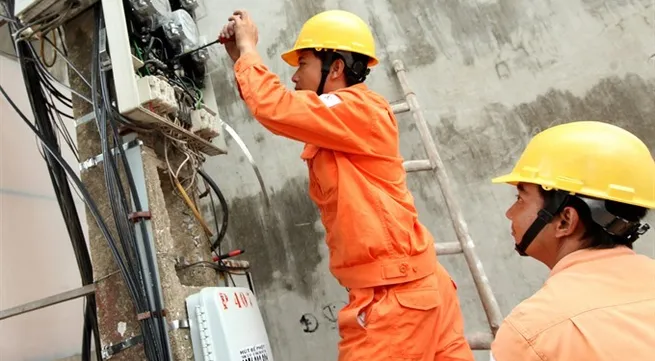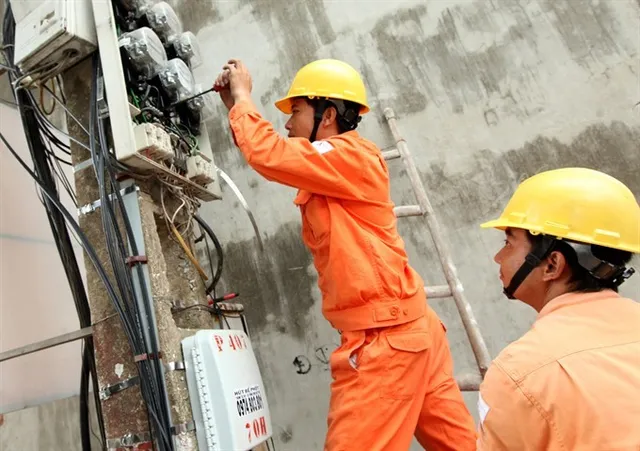Việt Nam to face power shortage by 2030
by ,http://vietnamnews.vn/economy/463521/viet-nam-to-face-power-shortage-by-2030.html10 August 2018 Last updated at 08:29 AM


|
| Electrical workers of EVN Hà Nội check an electrical system in the city. It is forecast that up to 2030, demand for electricity will continue to grow at a high level. — VNA/VNS Photo Ngọc Hà |
HÀ NỘI — Việt Nam will likely face a power shortage in the period 2020-30 if electricity generation is not increased and there is not enough fuel (coal and gas) for generation.
The warning was made at the Việt Nam Energy Forum held by the Ministry of Industry and Trade (MoIT) in Hà Nội on Thursday.
According to Việt Nam Electricity (EVN), to meet electricity demand for socio-economic development up to this year, EVN has completed 40 power plants with total capacity of 20,586MW.
By the end of 2018, total installed capacity of the sector is expected to reach 47,768MW (5.41 times higher than in 2003), ranking second in ASEAN (after Indonesia) and 25th in the world.
It is forecast that up to 2030, demand for electricity will continue to grow at a high level. The electricity sector will need to ensure 265-278 billion kWh by 2020 and around 572-632 billion kWh by 2030.
Thus, the growth rate in the period 2016-20 is 10.3-11.3 per cent per year and the period 2021-30 about 8-8.5 per cent.
Ngô Sơn Hải, Deputy General Director of EVN, said that the electricity supply in the years 2019-20 could be ensured. However, oil-fired thermal power plants would have to generate approximately 4.4 billion kWh by 2019 and 5.2 billion kWh by 2020.
“During the years 2021-30, the electricity system may not meet demand and power shortages could occur in the south,” said Hải.
Hải said power shortages may increase up to 2025 under scenarios including high load or the volume of water in reservoirs being lower than previous years. Furthermore, the gas projects of Bloc B and Cá Voi Xanh (Blue whale) and several others are being conducted slowly compared with the plan.
"Each of the 1,200MW coal-fired power plants in the south facing slow progress will worsen the shortage by 7.2-7.5 billion kWh per year," said Hải.
Energy saving
According to the adjusted power plan VII, in the five years from 2018 to 2022, the total capacity of the planned power sources is 34,864MW, of which thermal power makes up 26,000MW.
The EVN representative said that only seven coal-fired power plants with capacity of 7,860MW were currently under construction. As such, over 18,000 to 26,000MW of coal thermal power projects are expected to be operational in the next five years, however, as construction has not started this will greatly affect power supply.
There are views that coal-fired power plants are the main cause of environmental pollution, affecting the lives of people living around the plant.
"This is one of the reasons why the location of coal-fired thermal power plants has become increasingly difficult due to the lack of support from the locality and people where the plant is to be built,” said a representative from Việt Nam National Coal and Mineral Industries Group (Vinacomin).
According to experts at the conference, the urgent issue is how to improve energy efficiency, particularly in the context of the gradual exhaustion of fossil fuel resources. Most countries are under pressure to source energy for economic development.
Statistics by the Việt Nam Energy Association show that in 2017, production and purchase of electricity stood at about 199 billion kWh. Of this, renewable energy accounted for 44.2 per cent, the remaining 54.6 per cent from fossil fuels (gas, coal, oil) and 1.2 per cent from imports.
The association’s vice chairman Nguyễn Văn Vy said that although the potential for renewable energy was huge, the development of renewable energy projects required a large initial investment to build infrastructure such as roads and water systems.
Former Minister of Science and Technology Nguyễn Quân said that in the context that Việt Nam stopped nuclear power projects in the southern province of Ninh Thuận, the power sector’s plan had some gaps and needed solutions for replacement.
“Việt Nam needs to be self-reliant with renewable energy technologies, especially solar and wind energy,” said Quân.
“Many smaller countries are exporting technology and reaching out to the world, so Vietnamese scientists need to focus on mastering technology to ensure energy security for the country," he added.
At the conference, the MoIT’s Department of Electricity and Renewable Energy reported that the target of Việt Nam’s energy development would be to promote the development of renewable energy, including small and medium hydro-electric plants, wind and solar power, biomass, biogas and biofuels.
In addition, it needs to maintain the proportion of renewable energy in the total primary energy supply at above 30 per cent by 2035, and move towards the efficient use of energy, contributing to ensuring energy security, reducing reliance on imported energy and strengthening environmental protection. — VNS





